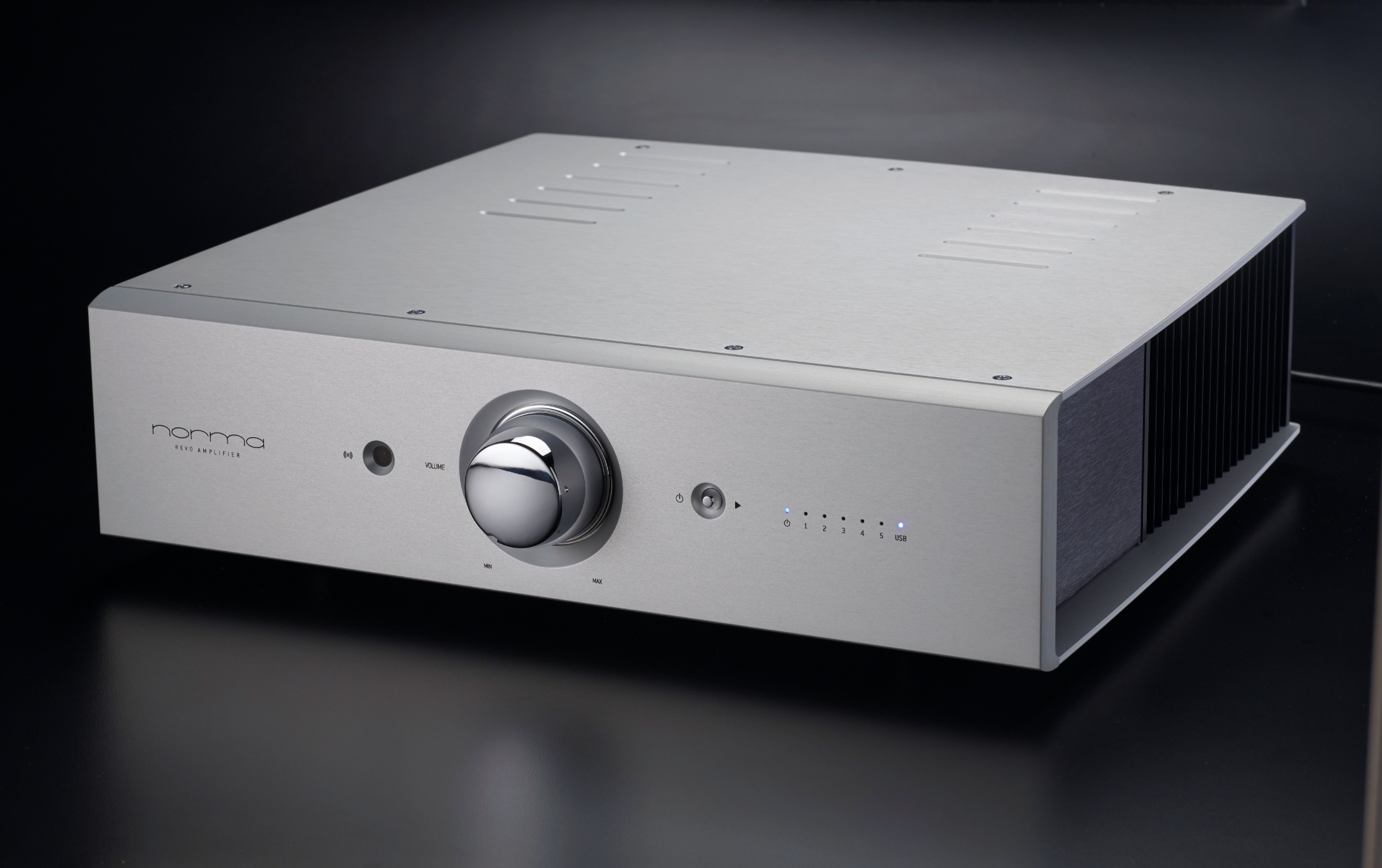
I recently revisited a book so rich in historical detail and visually evocative that one feels as if air-dropped onto the unpaved, rough-and-tumble, frequently plague-ridden streets of 15th-century Florence.
Authored by Ross King, Brunelleschi’s Dome: How a Renaissance Genius Reinvented Architecture spins a tale of political intrigue, back-stabbing rivalries, and the engineering brilliance essentially invented step-by-step by Filippo Brunelleschi as he designed what remains the largest masonry dome ever built, that of the cathedral of Santa Maria del Fiore—known to most of us simply as Il Duomo.
Given Italy’s exceptional history in the fine arts, as well as the country’s impact on modern commercial design—from automobiles to furniture, espresso machines to fashion—it’s little wonder that high-end Italian audio components are likewise striking things to behold. A prime example is the Norma Audio Revo IPA-140 integrated amplifier reviewed here.
Founded by Enrico Rossi, Norma Audio dates to 1987 with the release of its first amplifier. But things truly began to take shape a few years later when the company was acquired by Opal Electronics, a maker of electronic measuring devices.
With a new arsenal of tools at his disposal, Rossi began a multi-year exploration of the myriad ways in which electronic circuits, power supplies, and component parts interact can either enhance or degrade music reproduction.
Based in Cremona and steeped in that city’s history of exceptionally fine fiddle makers, Rossi and his team at Norma aim to merge their sophisticated technical know-how with a keen sensitivity to music. As the company’s website states: “The result of this endeavor is a unique sound, which represents a synthesis of parameters usually set one against each other: dynamics, speed, and absolute transparency are combined with extraordinary musicality and total lack of listening fatigue.”
That aesthetic was combined with the industrial design talents of Livio Cucuzza—currently Chief Design Officer for the McIntosh Group. You might even say it was fated.
Growing up in Sicily, Cucuzza’s father owned an audio shop, and Livio has described how his passion for audio and its visual design was triggered by being introduced when young to gear from companies such as B&O, Braun, and Brionvega—surely the brands of choice for George Jetson in his Skypad apartment.
After studying industrial design in Milan, Cucuzza began his career working for Lego, but the audio field remained a passion. For three years he took freelance commissions from several audio firms, before joining Sonus faber in 2010. (Sonus faber’s now parent company is the abovementioned McIntosh Group, which also encompasses McIntosh, Wadia, Sumiko, and, until recently, when it sold the brand, Audio Research, which recently changed hands yet again.)
Some of Cucuzza’s earlier freelance work was for Norma Audio, including the piece under review here, the company’s top-of-the-line $9600 Revo IPA-140 integrated amplifier (which I’m told is the unit’s fifth incarnation, though Norma doesn’t make much fuss about that, as the original model’s designation reflects).
A cornerstone of Norma’s design philosophy is a dedication to low-noise, fast, and ultra-wide-bandwidth circuitry. In the case of the Revo 140, the latter is spec’d at a doubletake-inducing >2MHz. That’s megahertz, or greater than two million hertz. Uh, yeah, that’s pretty wide bandwidth alright.
Power-wise, as the unit’s name implies, the Revo delivers a healthy 140Wpc into 8 ohms, and doubles that to an impressive 280Wpc into a 4-ohm load, something I came to appreciate with my power-hungry, 4-ohm Magnepan 1.7i’s.
Peeking inside the chassis reveals a dual-mono configuration—two mirrored circuits beautifully constructed within the non-magnetic aluminum enclosure. Powering the IPA-140 are a pair of toroidal transformers, separate power supplies for gain, output, and driver stages, and six per-side MOSFET power devices rated at 150A peak output current. The heat sinks are discretely tucked underneath the bottom and top plates, so they’re invisible from both the front and top views.
The rear panel reflects the amp’s dual-mono construction, with mirrored inputs accommodating four pairs of RCAs and one set of XLR, as well as optional USB DAC and mm/mc phono.
Cucuzza’s minimalist industrial design for the IPA-140 exemplifies cleanliness of line and form following function. Indeed, some may find the Revo a bit austere. Me? I love simplicity of look as well as use. Moving left to right across the amp’s brushed aluminum faceplate (your choice of silver or black anodized), you’ll find a headphone jack, a large gleaming silver volume knob, a small pushbutton input selector, and a tiny array of LEDs indicating the selected input. That’s all, and all you need. The supplied remote naturally echoes these functions.
Sonically, the Revo is powerful enough to effortlessly drive the great majority of today’s speakers, but its inherently neutral balance and understated sonic elegance mean it’s no brute when it comes to expressing musical nuance. And as mentioned above, effortless power is something one really appreciates with speakers like Magnepans, which truly sing with enough juice to get them on their feet.
For example, listening to the great-sounding EMI LP of Klemperer’s Mahler Second, I was notably drawn into the way the Norma’s power and dynamic layering ushered the symphony through the architectural brilliance of Mahler’s sprawling and wildly fluctuating score: From the hushed beauty of the “Urlicht” movement, where the orchestra and mezzo at times rise from almost unimaginably hushed silences, into the labyrinthian, lengthy fifth, with its myriad shifts in tempi, dynamics, and mood, as well as orchestral and vocal forces, to the full-throttled climax wherein all converge to unleash massive waves of sound, the recording proved to be a thrilling ride with the Norma.
Never did the sound become strained, ragged, disjointed, or at all fatiguing. In fact, there were times when I wondered if my Maggies could keep up. But one very nice thing about current Magnepans—at least in my experience—is that, unlike earlier iterations, where you could “bottom out” the Mylar diaphragm against the magnetic screen, these panels seem capable of much greater SPLs.
Balance-wise, I found the Norma to be tonally quite neutral. While not leaning toward the warm spectrum, neither does it sound cold or clinical. Indeed, the IPA-140 is one of those components that pretty much gets out of the way and lets the music do its thing.
One will notice, say, during the lilting Andante of the Mahler Second, that the Revo may not deliver quite the burnished mahogany warmth of the string sections, the golden richness of the brass, or quite the air or depth of the finest separates, but it does come within striking distance, while surfing the dynamic waves with aplomb.
The Mahler Second also allowed the IPA-140’s top-to-bottom coherence to shine, something critical to true high-end performance. From the opening fury of the bowed basses to the chamber-like wind and harp passages, right through to the organ-powered finale, the full frequency spectrum always came across as sounding complete, cut from whole cloth, as they say.
In addition to the Maggies, I also had the chance to hear what the Norma could do when paired with a fine set of cone speakers, in this case the excellent Rosso Fiorentino Pienza stand-mounted two-way I reviewed in last year’s July/August issue.
Inherently warmer sounding than my 1.7is, the Pienza was equally adept at showing what the Revo can do. For example, on Thelonious in Action (Analogue Productions’ 45 pressing), an exceptionally live-sounding club-set from 1958 that’s one of my go-to LPs, cranking “Blue Monk” up to something close to you-are-there volume unleashed this band’s sweaty, let ’er rip energy. Monk’s famously jabbing, percussive piano playing, Roy Haynes’ rat-a-tat snare work—and his rollicking, ricochet solo near the tune’s conclusion—and Johnny Griffin’s fat, reedy-sounding, blues-drenched sax transported me some 65 years back in time.
Some of Lucinda Williams’ finest singing of the past decade can be heard on the Charles Lloyd and the Marvels + Lucinda Williams LP Vanished Gardens. The group’s take on the closing track, a shimmering, beautifully sensitive rendition of Jimi Hendrix’s “Angel,” again proved the Revo to be a most graceful portal to the music.
Indeed, in my months with this outstanding design I came to the conclusion that for those who prefer the compact footprint of an integrated versus separates, who seek versatility of choice with its input options, and, most of all, listeners seeking an amplifier capable of both high power and musical nuance, the Norma Revo IPA-140 is something of a must-audition.
Specs & Pricing
Power output: 140Wpc into 8 ohms, 280Wpc into 4 ohms
Inputs: 4 RCA, 1 XLR balanced, mm/mc phono (optional), 1 USB DAC (optional)
Dimensions: 16.9″ x 4.3″ 14.4″ (excluding feet, knob, and rear jacks)
Weight: 55 lbs.
Price: $9600
AUDIOTHESIS (U.S. Distributor)
Arlington, Texas 76001
(682) 444-3121
audiothesis.com
normaaudio.com
Tags: AMPLIFIER INTEGRATED NORMA

By Wayne Garcia
Although I’ve been a wine merchant for the past decade, my career in audio was triggered at age 12 when I heard the Stones’ Get Yer Ya-Ya’s Out! blasting from my future brother-in-law’s giant home-built horn speakers. The sound certainly wasn’t sophisticated, but, man, it sure was exciting.
More articles from this editorRead Next From Review
See all
High-End Audio Buyer’s Guide 2024: DALI Oberon 5
- Jul 02, 2024

Best Headphones: Meze Audio Empyrean II Review
- Jul 02, 2024

Hegel H600 Streaming Integrated Amplifier
- Jun 28, 2024




















